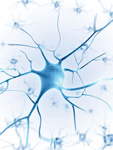Testing The Strength Of Our Nerves
Different levels of testing can uncover a variety of neuromuscular disorders
We often think of muscles as the source of our strength. But without the help of our nervous system, our voluntary muscles would weaken to the point of uselessness, and in some cases the lack of communication between nerve cells and muscle cells can be
life-threatening. Neuromuscular disorders are diagnosed and treated by neurologists like Jonas Vanags, MD, at St. Joseph's/Candler Medical Group – Neurology. Some of the most common diagnostic tools that Dr. Vanags uses are nerve conduction
studies (NCS) and electromyography (EMG).

“A routine EMG can help diagnose a number of nerve disorders or muscle disorders,” Vanags says. “The first part of our testing is called a nerve conduction study, in which we put electrodes either over the nerve or over a muscle supplied
by the nerve. We use electrical stimulation to record how fast and strong the nerve responds.”
The second part of the testing is the EMG. With this procedure, a tiny needle is inserted into the muscle. The needle detects electrical
activity from the muscle, and that activity is analyzed.
“We look at the muscle activity at rest and then when the patient contracts the muscle,” Vanags explains. “From this, we can tell several things. We can see if there
has been damage to the nerve going to the muscle or if there is a problem with the muscle itself.”
Some of the conditions the Dr. Vanags can diagnose through NCS and EMG testing include:

- Peripheral neuropathy (damage to peripheral nerves that causes numbness, pain or weakness, usually in hands or feet)
- Focal nerve disorders, such as carpal tunnel syndrome
- Radiculopathy (a nerve root disorder that affects the neck and back)
- Myopathies (muscular disease that is not caused by a defect in the nerves)
However, certain disorders may require further tests that, because of the skill and expertise required to successfully perform them, are not widely offered. One of these tests is the single fiber EMG.
“If I suspect that someone
has a disorder of the junction point between the nerve and the muscle, called the neuromuscular junction, I can perform further studies such as the single fiber EMG,” Vanags says. “This test also uses tiny needle, but this one is specifically
designed with a small port that is the size of microns. We insert this needle into the muscle and position it between two single muscle fibers that share the same nerve supply.”
If both of these single muscle fibers do not fire at
the same time, Dr. Vanags can determine whether there is a disorder of the neuromuscular junction.
“We test at least twenty pairs of these muscle fibers and then calculate the percentage to make the diagnosis,” Vanags says.
“It is a complicated test that requires a physician to have tremendous patience and great control of his or her hands. But it is an extremely valuable diagnostic tool.”

The single fiber EMG is considered the
best test for the diagnosis of myasthenia gravis, a neuromuscular disease in which antibodies caused by an overactive immune system block communication at the neuromuscular junction. This leads to weakness of skeletal muscles.
“Mild
symptoms of myasthenia gravis may be drooping eyelids or double vision,” Vanags says. “But if it is more severe, it can cause chewing, swallowing, and breathing problems, or limb weakness. If severe enough, it can become life-threatening.”
This is a very treatable condition, and many patients can achieve clinical remission. Getting an accurate diagnosis is the first step. That is why it is important for Dr. Vanags to offer single fiber EMG as a diagnostic test.
“This
is not the most comfortable procedure, but the stakes are high, and no other test has the same sensitivity and specificity,” Vanags says. “With a very strong certainty, the single fiber EMG can rule in or rule out myasthenia gravis, better
than any other test in the world.”
Learn more at www.sjchs.org/neurology.